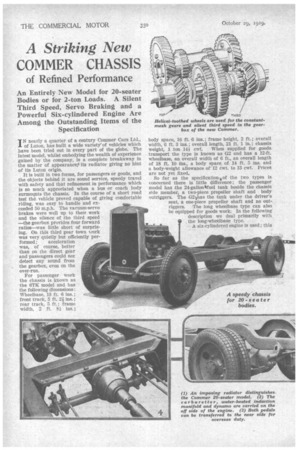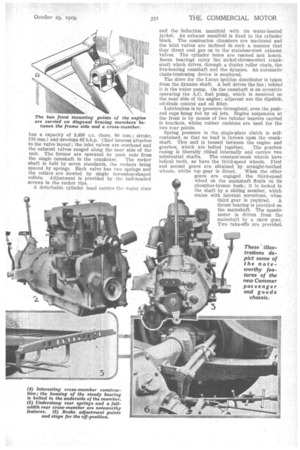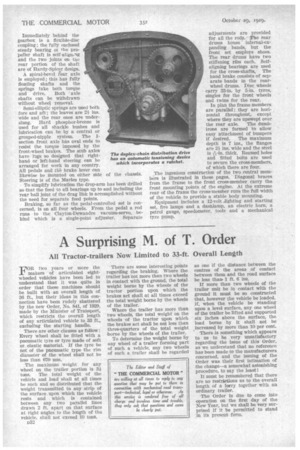A Striking New
Page 92

Page 93

Page 94

If you've noticed an error in this article please click here to report it so we can fix it.
COMMER CHASSIS
of Refined Performance
An Entirely New Model for 20-seater Bodies or for 2-ton Loads. A Silent Third Speed, Servo Braking and a Powerful Six-cylindered Engine Are Among the Outstanding Items of the Specification
TN nearly a quarter of a century Commer Cars Ltd., of Luton, has built a wide variety of vehicles which have been tried out in every part of the globe. The latest model, whilst embodying the wealth of experience gained by the company, is a complete breakaway in the matter of appearanc0 its radiator giving no hint of its Luton origin.
It is built in two forms, for passengers or goods, and the objects behind it are sound service, speedy travel with safety and that refinement in performance which is so much appreciated when a bus or coach body surmounts the chassis. In the course of a short road test the vehicle proved capable of giving comfortable riding, was easy to handle and exceeded 50 m.p.h. The vacuum-servo brakes were well up to their work and the silence of the third speed —the gearbox provides four forward ratios—was little short of surprising. On this third gear town work was very quietly but efficiently per formed; acceleration was, of course, better than on the direct gear and passengers could not detect any sound from the gearbox, even on the over-run.
For passenger work the chassis is known as the 6TK model and has the following dimensions : Wheelbase, 13 ft. 6 ins.; front track, 5 ft. 2i ins.; rear track, 5 fr.; frame width, 2 ft. 81 ins.;
body space, 16 ft. 6 ins.; frame height, 2 ft.; overall width, 6 ft. 3 ins.; overall length, 21 ft. 1 in.; chassis
weight, 1 ton 141 cwt. When supplied for goods transport the type is known as 02 and has a 12-ft. wheelbase, an overall width of 6 ft., an overall length of 18 ft. 10 ins., a body space a 14 ft. 5 ins, and a body-weight allowance of' 12 cwt. to 13 cwt. Prices are not yet fixed.
So far as the specification-oof the two types is concerned there is little difference; the passenger model has the 24-gallonlifuel tank beside the chassis side member, a two-piece propeller shaft and body outriggers. The G2%has the tank under the driver's seat, a one-piece propeller shaft and no outriggers. The long wheelbase type can also be equipped for goods work. In the following description we deal primarily with the long-wheelbase type.
A six-cylindered engine is used ; this
has a capacity of 3,498 c.c. (bore, 80 mm.; stroke, 116 mm.) and develops 65 b.h.p. Chief interest attaches to the valve layout'; the inlet valves are overhead and the exhaust valves ranged along the near side of the unit. The former are operated by push rods from the single camshaft in the crankcase. The rocker shaft is held by seven standards, the rockers being spaced by springs. Each valve has two springs and the collars are located by single horseshoe-shaped collets. Adjustment is provided by the ball-headed screws in the rocker tips.
A detachable cylinder head carries the water riser
and the Induction manifold with its water-heated jacket. An exhaust manifold is fixed to the cylinder block. The combustion chambers are machined and the inlet valves are inclined in such a manner that they direct cool gas on to the stainless-steel exhaust. valves. The cylinder bores are reamed and honed. Seven bearings carry the nickel-chrome-steel crankshaft which drives, through a diiplex roller chain, the five-bearing camshaft and the dynamo. An automatic chain-tensioning device is employed.
The drive for the Lucas ignition distributor is taken from the dynamo shaft. A belt drives the fan ; behind it is the water pump. On the camshaft is an eccentric operating the A.C. fuel pump, which is mounted on the near side of the engine; adjacent are the dipstick, oil-drain control and oil filter.
Lubrication is by pressure throughout, even the pushrod cups being, fed by oil jets. Engine suspension at the front is by means of two tubular bearers carried in brackets, whilst rubber cushions are used for the two rear points.
Spring pressure in the single-plate clutch is selfcontained, so that no load is thrown upon the crankshaft. This unit is housed between the engine and gearbox, which are bolted together. The gearbox casing is liberally, ribbed internally and carries two substantial shafts. The constant-mesh wheels have helical teeth, as have the third-speed wheels. First and second gears are obtained by straight-toothed Wheels, whilst top gear is direct. When the other gears are engaged the third-speed wheel on the mainshaft floats on its phosphor-bronze bush ; it is locked to the shaft by a sliding member, which mates with internal serrations, when third gear is required.
thrust bearing is provided on the mainshaft. The speedometer is driven from the mainshaft by a skew gear. Two take-offs are provided.
Immediately behind the gearbox is a flexible-disc coupling; the fully enclosed steady bearing ca the propeller shaft is self -a:lig/big and the two joints on the rear portion of the shaft are of Hardy-Spicer design.
A spiral-bevel fear axle is employed ; this has fully floating shafts and the springs take both torque and drive. Both ' axle shafts can be withdrawn without wheel removal.
Semi-elliptic springs are used both fore and aft ; the leaves are 21 ins. wide and the rear ones are underslung. Hard phosphor-bronze is used for an shackle bushes and lubrication can he by a central or grouped-nipple system. The Isection front axle has oval ends to resist the torque imposed by the front-wheel brakes. The stub axles have lugs so designed that righthand or left-hand steering can be arranged for work in any country. All pedals and the brake lever can likewise be inountecl on either side of the chassis. Steering is of the Merles type.
To simplify lubrication the drop-arm has been drilled so that the feed to all bearings up to and including the rear ball joint of the drag link is accomplished without the need for separate feed points.
Braking, so far as the pedal-controlled set is concerned, is on all four wheels. From the pedal a rod runs to the Clayton-Dewandre vacuum-servo, behind which is a single-point adjuster. Separate adjustments are provided for all the rods. • The rear drums house internal-expanding bands, but the front set employs shoes. The rear drums have two stiffening ribs each. Selfaligning bearings are used for the cross-shafts. The hand brake consists of separate bands in the rearwheel drums. Disc wheels carry 33-in. by 5-in. tyres, singles for the front wheels and twins for the rear.
In plan the frame members are parallel: they are horizontal throughout, except where they are upswept over the rear axle. The dumbirons are formed to allow easy attachment of bumpers if desired. The maximum depth is 7 Ms., the flanges are 21 ins, wide and the steel is -s-in. thick. Reamed holes and fitted bolts are used to secure the cross-members, of which there are four.
The ingenious construction of the two central members is illustrated in these pages. Diagonal braces from the frame to the front cross-member carry the front mounting points of the engine. At the extreme rear of the frame the cross-member runs the full width of the vehicle to provide a stable body mounting.
Equipment includes a 12-volt ..lighting and starting set, five lamps and a dashlamp, an electric horn, a petrol gauge, speedometer, tools and a mechanical tyre pump.




























































































































































































